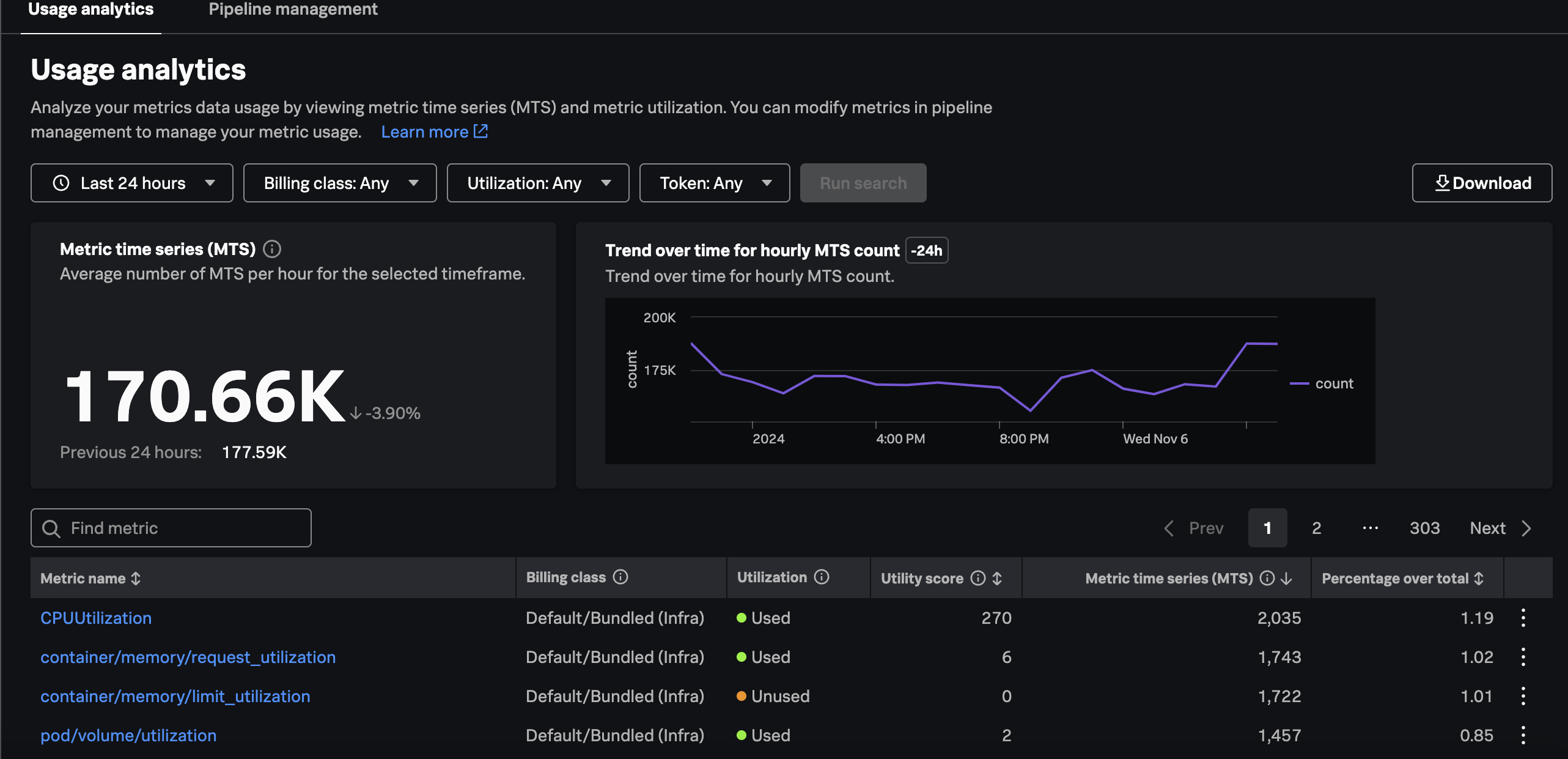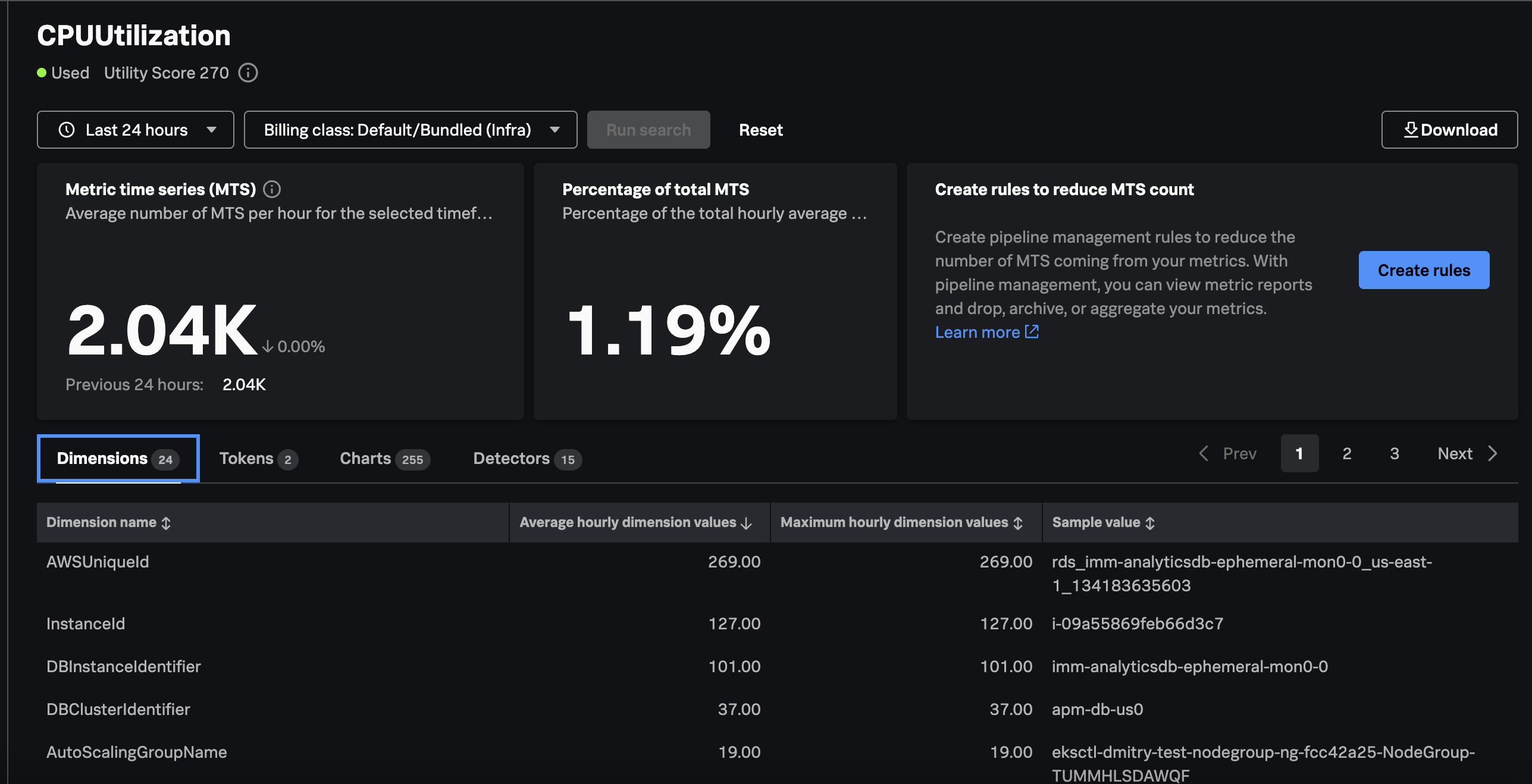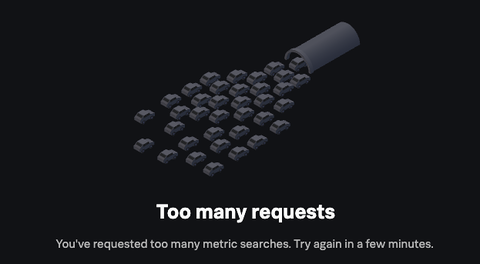Splunk Observability Cloud のメトリクス使用状況を分析する 🔗
使用状況分析では、Splunk Observability Cloud でのメトリクスの使用状況を詳細に視覚化できます。例えば、特定のメトリクスを集計、アーカイブ、削除するかどうかを決定する場合など、使用状況分析はメトリクスについて十分な情報に基づいた決定を下すのに役立ちます。
使用状況分析の使用方法については、メトリクスの使用状況を表示し、理解する を参照してください。
使用状況分析を使って、全体的なメトリクス使用量を管理し、削減するためのガイダンスについては、メトリクス使用量の管理と削減 をご覧ください。
メトリクスタイプの使用状況と請求については、サブスクリプションの使用状況と請求を監視および管理する を参照してください。
使用状況分析のメリット 🔗
使用状況アナリティクスを使用すると、組織がどのメトリクスを使用しているのか、またこれらのメトリクスが月全体の使用量にどのように寄与しているのかをすばやく見つけ、視覚化することができます。この情報があれば、全体的な使用量を削減する目的で、個々のメトリクスをどのように管理するかを正確に決定できます。
使用状況分析は、以下のシナリオ例を完成させるのに役立ちます:
メトリクス使用プランの大部分を占めているカーディナリティの高いカスタムメトリクスを表示したいと思っています。
チームがどのようなメトリクスを出しているかを特定し、その有用性を評価できるようにしたいと思います。
あるメトリクスのソースと所有権を見つけ、それを修正または調整できるようにしたいと思っています。
メトリクスの使用状況を表示し、理解する 🔗
使用状況分析では、使用計画に対するメトリクスの使用状況を判断するのに役立ついくつかのチャートや視覚エフェクトが表示されます。
使用状況分析では、メトリクスがどのディメンションを使用しているか、メトリクスがどのトークンに関連付けられているか、メトリクスがどのチャートに表示されているかなど、個々のメトリクスの詳細を確認することもできます。
アクセス使用状況分析 🔗
Splunk Observability Cloudで 使用状況分析にアクセスするには、以下の手順に従います:
Splunk Observability Cloudで、Settings を選択します。
Data Configuration で、Metrics Management を選択します。
Usage analytics タブを選択します。
使用状況分析のホームページには、以下の視覚エフェクトが含まれています:
選択した時間枠の 1 時間あたりの平均メトリック時系列(MTS)数を表示するカード。
選択した時間枠での 30 分ごとの平均 MTS 数を表示するグラフ。
各メトリクスとその使用状況を表示する、メトリクステーブル。これらの値の解釈については、メトリクステーブルでメトリクスの使用状況を把握する を参照してください。

注釈
使用状況分析では、APM Monitoring MetricSets、RUM Monitoring MetricSets、またはデフォルト/バンドル APM メトリクスは表示されません。使用状況分析の詳細については、Splunk Observability Cloud のメトリクス使用状況を分析する を参照してください。
メトリクステーブルでメトリクスの使用状況を把握する 🔗
メトリクス使用状況テーブルには、以下のフィールドが表示されます:
フィールド |
説明 |
|---|---|
メトリクス名 |
メトリクスの名前。 |
請求分類 |
課金目的のメトリクスのクラス(ホスト、課金、またはカスタム)。使用状況分析では、APM Monitoring MetricSets または RUM Monitoring MetricSets は表示されません。課金クラスの詳細については、メトリクスカテゴリ を参照してください。 |
使用率 |
メトリクスが使用されているかどうか。[未使用] は、メトリクスが MTS を生成していることを示しますが、これらの値は Splunk Observability Cloud では利用されません。 |
ユーティリティスコア |
そのメトリクスがどの程度使用されているかを示します。高いユーティリティのスコアは、使用量が多いことを意味します。 |
メトリック時系列(MTS) |
1 時間当たりのこのメトリクスに関連する平均 MTS 数。 |
合計の割合 |
総使用プランのうち、このメトリクスが利用する割合。 |
ページ上部のオプションを使用して、時間、課金クラス、使用状況、トークンでメトリクスをフィルタリングできます。
例えば、未使用のメトリクスだけを表示したい場合は、以下のステップに従います:
Utilization: Any のあるボックスを選択します。
メニューで、Unused を選択します。
Run search を選択します。
サーチを実行した後、使用状況分析ページには未使用のメトリクスのみが表示されます。サーチを元に戻すには、Reset を選択します。
注釈
過去 24 時間ではなく過去 30 日間のメトリクスをサーチするなど、より多くの結果が得られるフィルタでサーチを実行すると、サーチの実行速度が遅くなる場合があります。
メトリクスプロファイルでディメンション、トークン、チャートを表示する 🔗
使用状況分析には、各メトリクスのメトリクスプロファイルが含まれます。メトリクスプロファイルにアクセスするには、メトリクスの使用状況テーブルでメトリクスのいずれかを選択します。
メトリクスプロファイルでは、メトリクスに関する追加情報が記載されている以下のテーブルが利用できます:
テーブル |
説明 |
備考 |
|---|---|---|
ディメンション |
各メトリクスのディメンション名を 1 時間あたりの平均 MTS 数でソートして表示します。カーディナリティの高いディメンションがリストの最上位に表示されます。 |
最大5000のディメンションを表示します。 |
トークン |
各メトリクスのトークン名と ID をトークンに関連付けられたメトリック時系列の数でソートして表示します。 |
最大5000のトークンを表示します。 |
チャート |
各メトリクスに関連するグラフとダッシュボード、およびグラフを最後に更新したユーザーと更新時刻を表示します。 |
なし |
ディテクター |
各メトリクスに関連付けられたディテクターと、そのディテクターを最後に更新したユーザーと更新時刻を表示します。 |
なし |
たとえば、次のメトリクスプロファイルは、メトリクスのディメンションを含む CPUUtilization メトリクスに関する情報を表示します:

メトリクス使用量の管理と削減 🔗
このセクションには、メトリクスの使用量を削減する目的で、集約、アーカイブ、または削除できるメトリクスを特定するためのヒントが含まれています。
未使用メトリクスをアーカイブまたはドロップ 🔗
メトリクステーブルを使用すると、使用されていないメトリクスを見つけることができます。使用していないメトリクスがある場合は、アーカイブして使用プランの占有を減らすことができます。
アーカイブされたメトリクスは、Splunk Observability Cloud 内のアーカイブルートに移動します。そこで未使用の状態を維持して、請求コストを抑えます。再度使用する必要がある場合は、いつでもアーカイブルートから取り出すことができます。
メトリクスのアーカイブの詳細については、アーカイブされたメトリクス を参照してください。
これらのメトリクスを使用しておらず、将来も使用する予定がない場合は、使用領域を節約するためにメトリクスを削除することを検討してください。メトリクスの削除について詳しくは、データルーティングを使用して、メトリクスの保存、アーカイブ、破棄を行います。 を参照してください。
ユーティリティスコアが低いメトリクスを見つけて集約する 🔗
ユーティリティスコアが低いメトリクスがある場合は、それらを集約してメトリクスの総数を減らすことを検討してください。
これらのメトリクスを集計するかどうかを決めるには、以下の手順に従ってください:
集計を検討しているメトリクスを選択して、メトリクスプロファイルを開きます。
Detectors タブを選択し、メトリクスがディテクターに表示されるかどうかをチェックします。
ディテクターにそのメトリクスが表示されない場合は、Charts タブをチェックし、どのチャートがそのメトリクスを使用しているかを確認します。
そのメトリクスが、それぞれのチャートで維持することが重要かどうかを検討します。重要でない場合は、使用量を減らすためにメトリクスを他のディメンションと集約します。
メトリクスを集計する方法については、集計ルールを使ってデータ量をコントロールする を参照してください。
メトリクスのカーディナリティを減らす 🔗
カーディナリティの高いメトリクスがある場合は、ルーティング例外ルールを使用して特定の MTS を再ルーティングすることを検討してください。例えば、使用していないディメンションを持つ MTS をアーカイブまたは削除できます。
ルーティング例外ルールについて詳しくは、ルーティング例外ルールを使用して、特定の MTS をルーティング、またはアーカイブされたデータをリストアします。 を参照してください。
